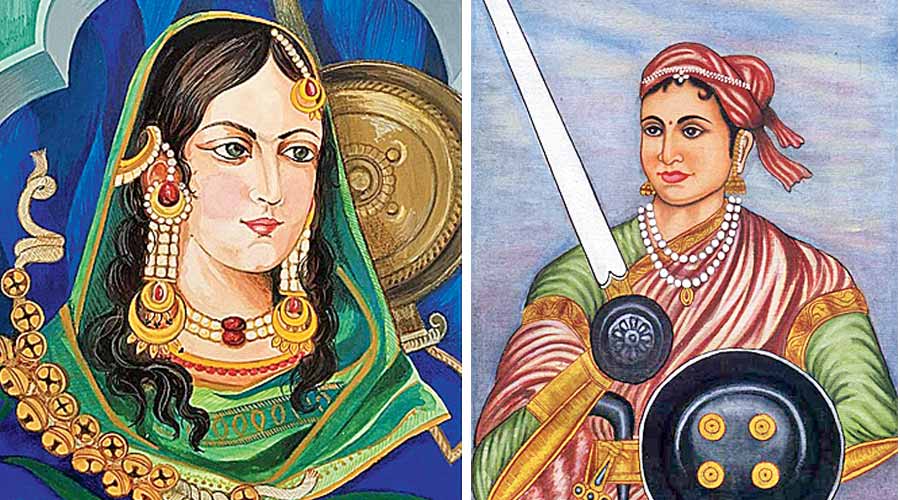Book: A Begum & A Rani: Hazrat Mahal and Lakshmibai in 1857
Author: Rudrangshu Mukherjee
Publisher: Allen Lane
Price: Rs 699
Rudrangshu Mukherjee’s latest book on the 1857 rebellion, A Begum & A Rani, retells the history of the 1857 rebellion around the activities of two North Indian women. The book asks why Indians revere the Rani of Jhansi but know little about Begum Hazrat Mahal. In the process of responding to this question, Mukherjee prods us to think about why we remember and record our national histories in the ways that we do: why and how did the begum go missing from the historical narratives produced after 1857 while the Rani of Jhansi had a regiment named after her? Mukherjee’s account probes why nations forget some historical figures, as he offers a lesson on how we might understand the power of national historical narratives.
Mukherjee is an experienced and well-regarded historian whose research transformed what many historians believed about the 1857 rebellion. From the time he was a PhD student, he has challenged conventional historical accounts. He revised a common understanding (generated by some British observers) of the events of 1857 as random and disorganized; instead, he showed that the rebels had a keen sense of justice as they fought to depose British officers and commanders across North India. Along with a group of revisionist historians, Mukherjee and others argued that the rebels were able to form alliances among different communities who lived in the Gangetic plains to forge a campaign that threw the British in India into disarray from the early months of 1857 into 1858. As he writes, “The rebellion is far too often seen, by historians of different persuasions, to be devoid of a mind or a consciousness. But it had a mind or perhaps several minds.”
At the risk of spoiling the conclusion, the book tells us about the history of Hazrat Mahal to draw attention to the exclusions of the histories of 1857. There are many possible reasons that a range of Indian writers, political leaders, and activists have embraced the figure of the Rani of Jhansi and ignored the involvement of the Begum. Mukherjee delivers these reasons slowly and methodically. He attaches important documents as evidence for his arguments, in addition to the footnotes that appear at the back. He is so methodical in illuminating his evidence that many readers may not notice that the book explains how historians have (over a long century and a half) ignored the historical interventions of a Black Muslim woman who was central to one of the most widely written about events in the history of India’s freedom.
There are, no doubt, many reasons why Indians have amplified the history of the rani over the begum. Mukherjee reminds us that the Rani of Jhansi was a Brahmin queen of impeccable lineage. The events of 1857 put her in an unexpected position of having worked with the British before the rebellion and turning on them in the battles afterward. The begum was not an elite: born of an African father who had been enslaved, she was temporarily married to (and divorced from) Wajid Ali Shah, the Nawab of Awadh, when Wajid Ali Shah left Lucknow. When Wajid Ali Shah fled, the begum’s adolescent son, Birjis Qadr, was installed as a leader of the rebellion because he was a son of nawabi lineage. The begum never went into battle, but she was clearly a force for organizing the resistance in Lucknow. The documents that the begum was involved in drafting appear in the appendices; the begum’s proclamation to counter Queen Victoria’s proclamation show that she was a canny political operative who advanced the interests of the rebels as she managed her son’s interests.
Mukherjee concludes that the begum’s historical importance was generated by the events of 1857; she was thrust into these events because of her position as the mother of the leader installed in Lucknow. The rani, however, was already prominent because of her status as a high-caste queen. This difference in status was widened by how each woman responded to the rebellion. When it was clear that the rebels had no way forward, the begum fled to Nepal as the Indian forces fell. Unlike the Rani of Jhansi, who heroically died in battle, the begum lived in Kathmandu, away from British oversight and control. Mukherjee’s pithy assessment, “Death deifies; flight is an amnesiac”, suggests one reason why the begum has been forgotten in later accounts.
History was important to the colonial conquest; it was also important to Indian thinkers who wrote their own histories to articulate a response to the British. As Mukherjee writes: “When, in the course of the rising tide of nationalism, there was a search for a nationalist icon and the nationalists harked back to 1857, Hazrat Mahal was not even a candidate. Lakshmibai was the obvious choice.” Lakshmibai was commemorated by folk songs soon after her death; stories, novels, and historical accounts followed in the hundred years after the rebellion. Hazrat Mahal, on the other hand, was not nearly so visible either in 1857 or in historical accounts generated in the years after.
The comparison between the historical prominence of the rani and the begum is most important in directing us to the ways in which nationalist narratives have generated exclusions about who belongs to the nation. Many Indians might struggle to think of a Muslim woman trained as a courtesan and born of an enslaved African man as an appropriate nationalist heroine for the resistance against the British in 1857. Mukherjee offers us an account that pushes us to think about why we have not taken Hazrat Mahal more seriously.










